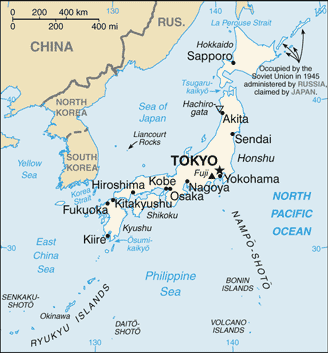Welcome All to Japan.....
 Irrasshaimase --- Welcome Now you know, how to Welcome in Japan:)
Irrasshaimase --- Welcome Now you know, how to Welcome in Japan:)About Japan:
 Japan is a country with capital as Tokyo, and of over three thousand islands extending along the Pacific coast of Asia.The characters which make up Japan's Name mean "sun-origin", which is why Japan is sometimes identified as the "Land of Rising Sun". Major Religions observed here are Shinto and Buddhism. Buddism, was first introduced in Japan, and then China was influenced my the Religion. About 70% to 80% of the country is forested, mountainous, and unsuitable for agricultural, industrial, or residential use. This is due to steep elevations, climate and risk of landslides caused by
Japan is a country with capital as Tokyo, and of over three thousand islands extending along the Pacific coast of Asia.The characters which make up Japan's Name mean "sun-origin", which is why Japan is sometimes identified as the "Land of Rising Sun". Major Religions observed here are Shinto and Buddhism. Buddism, was first introduced in Japan, and then China was influenced my the Religion. About 70% to 80% of the country is forested, mountainous, and unsuitable for agricultural, industrial, or residential use. This is due to steep elevations, climate and risk of landslides caused by
earthquakes, soft ground and heavy rain. Japan is also the most Densely Populated Country.
Places to Visit in Japan:
Tokyo is a blend of royalty, religion and entertainment.
The Imperial Palace grounds,
The Senso-ji Temple,
The Yashukuni-jinja shrine,
The Kabuki-Za Theatre,
The Ginza shopping district,
The Tokyo national museum,
The Odaiba entertainment district and
The Tsukiji Fish Market.
Kyoto is a city of culture and history. Visit the Kiyomizu Temple, the Golden Pavilion Temple, and the Ryugen-in Temple. Also, visit the Kyoto Imperial Palace, the Gion Geisha district and the Kyoto handicraft centre.
Other places worth visiting include the Nagasaki Atomic Bomb Museum, the Hiroshima Peace Memorial and the Atomic Bomb Dome, a skeletal site of the first bombing.
Nature lovers can make their way to Mount Fuji, Iriomote Jima, Matsujan Jo, Tohoku and the Nato Hanbo Peninsula.
About Japanese Cuisine:
There are many staple foods that are considered part of Japan's national cuisine today.The most common are Rice, Noodles and Soy.
There are many staple foods that are considered part of Japan's national cuisine today.The most common are Rice, Noodles and Soy.
1. Rice (gohan)
The rice most often served in Japan is of the short-grain Japonica variety. Rice is Japan's most important crop. Japanese rice is short grain and becomes sticky when cooked. Most rice is sold as hakumai ("white rice"), with the outer portion of the grains (nuka) polished away. Unpolished rice (gemmai) is considered less delicious by most people, but its popularity has been increasing recently because gemmai is more nutritious and healthier than hakumai.
A second major rice variety used in Japan is mochi rice. Cooked mochi rice is more sticky than conventional Japanese rice, and it is commonly used for sekihan (cooked mochi rice with red beans), or for pounding into rice cakes.
Rice is processed and prepared in many different ways.
Rice Cakes (mochi)
Rice Wine (sake or nihonshu)
Rice Flour &
Rice Flour &
Rice Vinegar
2. Noodles
Noodles often take the place of rice in a meal. They are featured in many soup dishes, or served chilled with a sauce for dipping. Soba and udon are two kinds of Japanese noodles. Soba is made from buckwheat flour and udon from wheat flour. They are served either in a broth or dipped in sauce and are available in hundreds of delicious variations.
3. Soy Bean and Tofu
Soya beans are one of the central ingredients of Japanese Cuisine. They constitute the base of many distinct Japanese tastes, notably soya sauce and tofu. The English name for soya beans come from the Japanese word for soya sauce, "shoyu".
Tofu
Tofu is soybean curd, pressed into blocks as fresh tofu or processed further. It is a staple ingredient of Japanese cuisine, which offers many different tofu dishes using many types of fresh and processed tofu. Tofu is often an ingredient in soups and stews.
Deep fried tofu is also used in many popular Japanese dishes.
Traditional Dishes of Japan:
Tempura is food deep-fried in vegetable oil after being coated with a mixture of egg, water and wheat flour.
For More on Japanese Cusine:
Instructions for the A.W.E.D - Japan:

(a) Prepare a Dish that is a Vegetarian[Egg’s are allowed].Non-Vegetarian not allowed.
(b) Post as many Japanese Dishes with Recipes as you like on your blog this April 2009. More entries per person are allowed.
(d) If you can include any info about Japanese Cuisine, in your post, it is very much appreciated.
(e) If you have any tip’s you wish to share on Japanese Dish, it will be so usefull.
(f) Use of the Logo to the event is also appreciated.Url of the logo image: "http://farm4.static.flickr.com/3616/3419898108_4463dcfa6f_o.jpg "
(g) I will also accept your old post’s, but you should link back to this announcement post and to DK's blog. Re-Publishing old post’s for A.W.E.D Japan will make me more happy!
(h) E-mail me to glassofhoney(AT)gmail(dot)com with SUBJECT as A.W.E.D - Japan know and along with the following details..
Your Name:
Your Blog Name:
Name of the Dish:
Link/URL of the Post:
Attach a Picture of the Dish. Size does not matter.
(i) Deadline for all the entries will be the 10'th of May-2009. I will do the roundup by 12'th of May-2009.
(j) If you don't have a blog, but you want to be part of this wonderfull event, you can send me your Recipe along with the picture of the dish. Dont forget to mention your name and your location.
Now Looking Forward for your Japanese Entrie's...
Sources:
http://www.placesonline.com/asia/japan/attractions.asp
http://www.jnto.go.jp/eng/
http://www.japan-guide.com/e/e2346.html
http://www.chinatownconnection.com/japanese_cuisine.html
http://japanesefood.about.com/od/recipeindex/tp/easyjapanese.html
http://en.wikipedia.org/wiki/List_of_Japanese_ingredients
Have a Korean Feast from Round up of A.W.E.D-Korean hosted by PJ..
- Follow RecipesDream
- Follow @us
